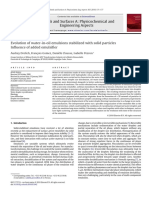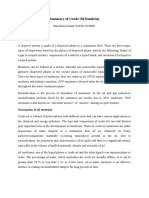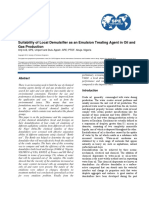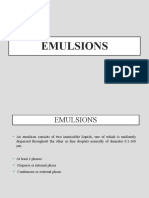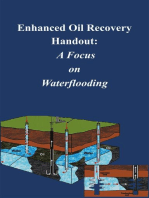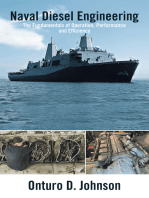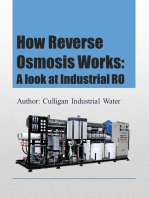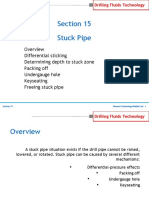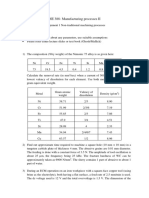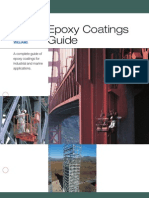Demulsifier
Demulsifier
Uploaded by
Ibrahim DewaliOriginal Description:
Copyright
Available Formats
Share this document
Did you find this document useful?
Is this content inappropriate?
Report this DocumentCopyright:
Available Formats
Demulsifier
Demulsifier
Uploaded by
Ibrahim DewaliCopyright:
Available Formats
Emulsion
sEng. Ibrahim Dewali
Understanding Emulsions
Understanding Emulsions: Factors Impacting Stability
An emulsion is a mixture of two immiscible liquids, such as oil and water, in
which one liquid is dispersed as small droplets within the other liquid. The
dispersed liquid is called the "internal phase," while the continuous liquid is
called the "external phase."
In the case of an oil and water emulsion, the oil droplets are the internal
phase, and the water is the external phase. The droplets are usually
stabilized by an emulsifying agent, which can be a surfactant or a natural
substance such as asphaltenes, resins, or waxes.
Emulsions can be classified based on the size of the droplets, which can
range from nanometers to microns. They can also be classified based on
the nature of the external phase, such as oil-in-water (O/W) or water-in-oil
(W/O) emulsions.
There are several factors that can impact the stability of an emulsion.
Here are some of the main ones:
1) Composition of the emulsion: The type and amount of the dispersed
and continuous phases, as well as the type and concentration of
emulsifying agent, can affect the stability of the emulsion.
2) Temperature: Emulsions can be sensitive to temperature changes, and
some may become unstable when heated or cooled.
3) Salinity: The presence of salt in the emulsion can affect the ionic
strength and surface tension, which can impact the stability of the
emulsion.
4) Shear forces: Shear forces, such as mixing or pumping, can cause the
emulsion droplets to collide and coalesce, leading to destabilization.
5) Time: Over time, emulsions can naturally separate due to gravity and
other factors, leading to phase separation.
Eng. Ibrahim Dewali
6) pH: The pH of the emulsion can affect the charge of the emulsifying
agent and the droplets, which can in turn affect their ability to repel or
attract each other.
Eng. Ibrahim Dewali
Centrifuge"
Spin crude oil at high RPMs in a centrifuge. Lighter hydrocarbons
separate, collecting at the top (BS). Heavy sediments sink, collecting at the
bottom (W). Measure volume of each layer. Subtract from total volume to
get quantity of oil (BS&W %).
The centrifuge spins the oil at extremely high speeds, allowing the
components to stratify by density. The lighter hydrocarbons float to the top
as the bottom sediment (BS&W) settles at the bottom. Simply measuring
the volumes of each layer and calculating the percentage of the total
volume gives the BS&W content of the crude
Eng. Ibrahim Dewali
Demulsification:
Demulsification: The Art and Science of Separating Immiscible Liquids
Have you ever wondered how oil and water can be separated after being
mixed together? This process is called demulsification, and it involves the
use of demulsifiers or emulsion breakers. These chemicals are designed to
disrupt the stability of the emulsion and cause the individual components to
separate.
Demulsifiers work by adsorbing at the oil-water interface, reducing the
interfacial tension between the two liquids, and promoting the coalescence
of droplets. They can also destabilize the emulsion by changing the
electrostatic charges on the droplets, causing them to repel each other and
aggregate.
There are various types of demulsifiers, including surfactants, polymers,
organic acids, and alkalis, each with its unique mechanism of action.
▪ Surfactants, for example, are the most commonly used type of
demulsifier and work by reducing interfacial tension and promoting
droplet coalescence.
▪ Polymers, on the other hand, can stabilize or destabilize the emulsion
depending on their structure and composition.
▪ Organic acids and alkalis, such as acetic acid and sodium hydroxide,
respectively, can also be used as demulsifiers.
The selection of a demulsifier depends on several factors, including the type
of emulsion, the composition of the immiscible liquids, and the desired
separation efficiency. In the oil and gas industry, for instance, the choice of
demulsifier takes into account the specific properties of the crude oil and
formation water, such as the temperature, pressure, and salinity of the
production stream.
Eng. Ibrahim Dewali
Demulsification involves various processes and mechanisms,
including
▪ Sedimentation
▪ Creaming
▪ Flocculation
▪ Ostwald ripening
▪ Coalescence
▪ Aggregation
▪ Phase separation.
These phenomena can occur together or individually, leading to gradual
changes in the properties of the emulsion.
Overall, demulsification is a fascinating and critical process that plays a vital
role in various industries, including oil and gas, food and beverage, and
pharmaceuticals. By understanding the art and science of demulsification,
we can improve separation efficiency, reduce environmental impact, and
optimize product quality.
Eng. Ibrahim Dewali
Common Processes and Mechanisms of Demulsification in
Emulsions
Emulsions are unstable systems that consist of two immiscible liquids, such
as oil and water, that are stabilized by an emulsifying agent. These
systems are thermodynamically unstable and tend to change slowly over
time. There are various phenomena involved in changing the properties of
an emulsion, including sedimentation, creaming, flocculation, Ostwald
ripening, coalescence, aggregation, and phase separation.
Flocculation is a phenomenon that occurs when droplets in an emulsion
collect through attractive interactions to form flocs of droplets.
Coalescence, on the other hand, occurs when the film between two
droplets ruptures, leading to the combination of droplets. The process of
gradual growth from coalesced droplets into larger droplets is defined as
Ostwald ripening. see attached picture!
The process of demulsification involves separating oil and water from
emulsions. Demulsification can occur through various mechanisms, such
as heating, the addition of chemicals, or applying an electric field. However,
Eng. Ibrahim Dewali
the complexity of the destabilization processes involved in colloid
chemistry, surfactants science, and interface phenomena makes it difficult
to draw a universal conclusion.
Chemical demulsification is influenced by several parameters, such as
temperature, salinity, water, and oil content. Changing these parameters
can either increase or decrease emulsion stability.
In general, the addition of a chemical demulsifier causes the emulsifying
agent to break down, leading to the separation of the oil and water phases.
Numerous chemical demulsification mechanisms have been reported,
including the use of surfactants, polymers, and coagulants. However, there
is still no universal conclusion regarding the best method to demulsify
emulsions due to the diversity of the destabilization processes involved,
The five popular theories of demulsification mechanisms are summarized in
the Table that attracted post
To learn more about the processes and mechanisms of demulsification,
you can refer to various sources such as "The Formation, Stabilization and
Separation of Oil–Water Emulsions: A Review" by Ying Tian and Jingjing
Zhou,
In summary, demulsification is a crucial process in the separation of oil and
water from emulsions. While there are numerous mechanisms and
parameters that can influence the process, the complexity of the
destabilization processes involved makes it difficult to draw a universal
conclusion. However, ongoing research is providing insights into how
chemical demulsification can be optimized to enhance emulsion stability
and efficiency.
Eng. Ibrahim Dewali
Eng. Ibrahim Dewali
Emulsion viscosity is a critical issue while performing flow assurance
analysis.
While emulsion viscosity might increase significantly if the water cut is
reaching to the inversion point on the emulsion viscosity curve, as emulsion
viscosity at inversion points might reach to hundreds or thousands of
centipoises depending on each crude properties and its calculated
emulsion viscosity curve. Below sample curve is showing the emulsion
viscosity curve based on the water cut and the highest viscosity peak on
the curve is known as the inversion point.
In such cases the back pressure would increase significantly due to the
high emulsion viscosity, and this needs to be considered while sizing the
pipe line considering applying mitigations strategies like injection of
demulsifier, heat tracing and in some cases water injection to increase the
water cut to avoid the inversion point zone, which will have significant
reduction of viscosity on the curve.
A challenge may come from water cut change across the life time of the
reservoir, so it has to be analysed periodically to avoid reaching to the
inversion point by applying suitable mitigations.
Also addressing the outcomes and mitigations from the flow assurance
study to the plant operating manual (POM) is critical to be strictly followed
by the operations team, and operations team needs to be aware of those
parameters from the plant operating manual to avoid interruptions in the
operation, as in some cases if operators is not exactly following the POM
and injecting more water in the pipelines with out proper flow assurance
analysis may move the viscosity to the inversion point, hence very high
back pressure which may reach to HIPPS or high high pressure trip set
points and tripping the system due to such increase in the back pressure.
Eng. Ibrahim Dewali
Conclusion
▪ Emulsion viscosity is very critical issue and needs to be fully analysed
and mitigated in the engineering phases.
Water cut needs to be analysed periodically across the life time of the
reservoir to ensure avoiding reaching to the inversion point by
performing the required mitigations if required.
▪ Outcomes of the flow assurance studies and considered mitigations
needs to be addressed in the plant operating manual (POM).
▪ Operations teams needs to be strictly following the plant operating
manual (POM) to avoid changing the considered basis in the design
which might have significant impact to the plant operation.
▪ Unplanned trips in pipelines is a production loss to the plant, hence a
negative cost impact due to interruptions of the plant productivity. So it
shall be avoided.
Eng. Ibrahim Dewali
Over Dosage of Demulsifer .
The first indicator of over dosage of demulsifier in an oil-water separation
process can vary depending on the specific demulsifier and the
characteristics of the emulsion being treated. However, some common
indicators of over dosage include:
1) Reduced separation efficiency: If too much demulsifier is added, it can
cause the oil droplets to coalesce excessively, resulting in larger
droplets that may not be easily separated from the water. This can
reduce the efficiency of the separation process, as it may require more
time, energy, or equipment to achieve the desired level of separation.
2) Formation of secondary emulsions: Over dosage can cause the
formation of secondary emulsions, which are new emulsions that form
during the separation process. This can occur when the excessive
demulsifier causes the oil droplets to coalesce too quickly, resulting in
the formation of new emulsions that are more difficult to separate.
3) Increase in oil content in the separated water: If too much demulsifier is
added, it can cause the separated water to have a higher oil content
than desired. This can result in water that appears oily or cloudy, and
may indicate that the demulsifier dosage needs to be adjusted.
4) Increased chemical consumption: Over dosage of demulsifier can result
in increased chemical consumption, as excess demulsifier may not be
fully consumed in the separation process. This can lead to higher costs
and may have negative environmental impacts.
Eng. Ibrahim Dewali
To avoid the negative impacts of over dosage, it is important to carefully
evaluate the emulsion and determine the appropriate dosage of demulsifier
needed to achieve effective separation. This may involve conducting Bottel
test and flied trials to determine the optimal dosage rate, and adjusting the
treatment process as needed to achieve the desired results.
Sources
- "Demulsification of Water-in-Oil Emulsion by Chemical Demulsifiers."
Journal of Dispersion Science and Technology, vol. 35, no. 12, 2014, pp.
1743-1753.
- "Demulsification of petroleum emulsions." Chemical Engineering Science,
vol. 62, no. 23, 2007, pp. 7056-7070.
Eng. Ibrahim Dewali
You might also like
- Chapter 10: Emulsion & Oil/Water Separation: I. Oil Export SpecificationDocument21 pagesChapter 10: Emulsion & Oil/Water Separation: I. Oil Export SpecificationThanh Tùng PhạmNo ratings yet
- Oil Based Mud or Fluids (OBM)Document7 pagesOil Based Mud or Fluids (OBM)mmohsinaliawanNo ratings yet
- Crude Oil Emulsions - Petroleum Engineers Handbook PDFDocument34 pagesCrude Oil Emulsions - Petroleum Engineers Handbook PDFMichael Grayson100% (3)
- How Industrial Businesses Can Reduce Production Costs With Reverse Osmosis: Industrial Reverse OsmosisFrom EverandHow Industrial Businesses Can Reduce Production Costs With Reverse Osmosis: Industrial Reverse OsmosisRating: 5 out of 5 stars5/5 (1)
- Sedra Chapter5Document111 pagesSedra Chapter5Gustavo Omar Mesones Málaga100% (2)
- 2005 Crude Oil Emulsions - A State-Of-The-Art ReviewDocument9 pages2005 Crude Oil Emulsions - A State-Of-The-Art ReviewOscar RoaNo ratings yet
- Emulsiones Organizado en InglésDocument9 pagesEmulsiones Organizado en Ingléspetitte92No ratings yet
- Ionic Liquids As Surfactants - Applications As Demulsifiers of Petroleum EmulsionsDocument22 pagesIonic Liquids As Surfactants - Applications As Demulsifiers of Petroleum EmulsionsHAFIZUL FURQANNo ratings yet
- Emulsion Treating Part1Document7 pagesEmulsion Treating Part1Sandy Msd100% (1)
- Emulsion Treating Part1Document6 pagesEmulsion Treating Part1Rizwan FaridNo ratings yet
- Separation Processes 2 Emulsion Treating: Nazir Mafakheri Petroleum EngineeringDocument57 pagesSeparation Processes 2 Emulsion Treating: Nazir Mafakheri Petroleum EngineeringHemenMoNo ratings yet
- Treatment of EmulsionDocument7 pagesTreatment of EmulsionSaurab DevanandanNo ratings yet
- DemulsifiersDocument3 pagesDemulsifiersAnand ChristyNo ratings yet
- Technique For Measuring The Composition (Oil and Water Content) of EmulsionDocument53 pagesTechnique For Measuring The Composition (Oil and Water Content) of EmulsionDesi Rahma PrihandiniNo ratings yet
- Demulsification &desalinationDocument59 pagesDemulsification &desalinationnilay05No ratings yet
- Crude Oil Emulsions A State-Of-The-Art ReviewDocument11 pagesCrude Oil Emulsions A State-Of-The-Art Reviewmalyari2002255100% (3)
- Effect-Of-Chemical-Breaking-Agents-On-Water-In - Crude-Oil-Emulsion-System OkDocument6 pagesEffect-Of-Chemical-Breaking-Agents-On-Water-In - Crude-Oil-Emulsion-System OkThiago Alejandro Villabona EstupiñanNo ratings yet
- H013760 Emulsion Breaker Product Selection and Treatment Philosophy SingleDocument5 pagesH013760 Emulsion Breaker Product Selection and Treatment Philosophy SingleThiago Alejandro Villabona EstupiñanNo ratings yet
- Oil Water SeparationDocument3 pagesOil Water SeparationrohitkushNo ratings yet
- Wet Crude ProcessingDocument39 pagesWet Crude ProcessingMohanad HussienNo ratings yet
- Industrial Preparation of Demulsifiers: Theory and ApplicationsDocument14 pagesIndustrial Preparation of Demulsifiers: Theory and Applicationswahab aliNo ratings yet
- Chapter 6 - Emulsifier - 2013 - Hydraulic Fracturing Chemicals and Fluids TechnoDocument8 pagesChapter 6 - Emulsifier - 2013 - Hydraulic Fracturing Chemicals and Fluids TechnoChristian PradaNo ratings yet
- Chapter 2 EmulsionsDocument52 pagesChapter 2 Emulsionsplq_macrossNo ratings yet
- OBMDocument7 pagesOBMmmohsinaliawan100% (1)
- Oil and Gas ProcessDocument5 pagesOil and Gas ProcesshichamNo ratings yet
- EmulsionsDocument14 pagesEmulsionsPaolo Cavaioni100% (1)
- SPE-63165-MS Emulsion Index PDFDocument12 pagesSPE-63165-MS Emulsion Index PDFGabriel EduardoNo ratings yet
- (Audrey Drelich 2010) Evolution of Water-In-Oil Emulsions Stabilized With Solid Particles Influence of Added EmulsifierDocument7 pages(Audrey Drelich 2010) Evolution of Water-In-Oil Emulsions Stabilized With Solid Particles Influence of Added EmulsifierJesus Ivan RomeroNo ratings yet
- Emulsion: Understanding EmulsificationDocument3 pagesEmulsion: Understanding EmulsificationArc AngleNo ratings yet
- Tugas EmulsiDocument5 pagesTugas EmulsiElan Patria NusadiNo ratings yet
- Suitability of Local Demulsifier As An Emulsion Treating Agent in Oil and Gas ProductionDocument8 pagesSuitability of Local Demulsifier As An Emulsion Treating Agent in Oil and Gas ProductionJonathan FariasNo ratings yet
- Emulsion Breaking PDFDocument22 pagesEmulsion Breaking PDFNovrie100% (1)
- Emulsion 002Document30 pagesEmulsion 002Manus AgereNo ratings yet
- The Effective Way of Separating WaterDocument38 pagesThe Effective Way of Separating WaterIrshad Muhammad100% (5)
- DA Final ReportDocument9 pagesDA Final ReportAmoluck BhatiaNo ratings yet
- EmulsionDocument10 pagesEmulsionfdt11No ratings yet
- Emulsions Electrostatic SeparatorsDocument20 pagesEmulsions Electrostatic SeparatorsRicardo BecNo ratings yet
- Emulsified Acid Systems For Oil Well Stimulation A ReviewDocument12 pagesEmulsified Acid Systems For Oil Well Stimulation A ReviewVivek FinoricNo ratings yet
- Assignment 1 EmulsionDocument25 pagesAssignment 1 EmulsionRajpurohit ChiragNo ratings yet
- EmulsionsDocument44 pagesEmulsionsMax Singh100% (1)
- 10 - Emulsions and Foams - 1992 - Introduction To Colloid and Surface ChemistryDocument15 pages10 - Emulsions and Foams - 1992 - Introduction To Colloid and Surface ChemistryAZUCENANo ratings yet
- Oil-Water Separation TechnogiesDocument4 pagesOil-Water Separation TechnogiesBrian FreireNo ratings yet
- EmulsionDocument1 pageEmulsionsahirmalik17No ratings yet
- EmulsiDocument45 pagesEmulsiMutiara SuprihantoNo ratings yet
- GE669Document14 pagesGE669nurul ainyNo ratings yet
- Emulsion BreakerDocument19 pagesEmulsion BreakerNovrie50% (2)
- Emulsion and ColloidDocument15 pagesEmulsion and ColloidsaravkiruNo ratings yet
- ASTMDocument10 pagesASTMGabriel EduardoNo ratings yet
- Crude Oil TreatmentDocument85 pagesCrude Oil Treatmentamiegy440No ratings yet
- Desalting Paper Musleh1Document18 pagesDesalting Paper Musleh1Ahmed Mohamed KhalilNo ratings yet
- Oil Based MudsDocument27 pagesOil Based MudsJames CarterNo ratings yet
- Emulsion: TM-4144 Surface Facilities and Transportation by Leksono MucharamDocument37 pagesEmulsion: TM-4144 Surface Facilities and Transportation by Leksono MucharamAditya KurniawanNo ratings yet
- 9-10 - Treatment of Oil - Treatment of GasDocument18 pages9-10 - Treatment of Oil - Treatment of GasaliyevallemannNo ratings yet
- Emulsion Stability and TestingDocument2 pagesEmulsion Stability and TestingVictor Lopez100% (1)
- Lecture: Surface Production Operations B Tech Sem-6 Petroleum Engineering Date: 14 November 2020 Professor Ashish NagarDocument88 pagesLecture: Surface Production Operations B Tech Sem-6 Petroleum Engineering Date: 14 November 2020 Professor Ashish NagarASHISH NAGARNo ratings yet
- Pharmaceutical Emulsions: (DR.) Mirza Salman BaigDocument41 pagesPharmaceutical Emulsions: (DR.) Mirza Salman BaigSantosh PayghanNo ratings yet
- Naval Diesel Engineering: The Fundamentals of Operation, Performance and EfficiencyFrom EverandNaval Diesel Engineering: The Fundamentals of Operation, Performance and EfficiencyNo ratings yet
- How Reverse Osmosis Works: A Look at Industrial ROFrom EverandHow Reverse Osmosis Works: A Look at Industrial RORating: 2.5 out of 5 stars2.5/5 (2)
- Soap-Making Manual. A practical Handbook on the RControl in the modern Soap PlantFrom EverandSoap-Making Manual. A practical Handbook on the RControl in the modern Soap PlantRating: 5 out of 5 stars5/5 (2)
- Machinery Oil Analysis & Condition Monitoring : A Practical Guide to Sampling and Analyzing Oil to Improve Equipment ReliabilityFrom EverandMachinery Oil Analysis & Condition Monitoring : A Practical Guide to Sampling and Analyzing Oil to Improve Equipment ReliabilityRating: 3.5 out of 5 stars3.5/5 (5)
- Byk Og-Ti 1 enDocument12 pagesByk Og-Ti 1 enIbrahim DewaliNo ratings yet
- Section - 21 DRILL CUTTINGS EVALUATIONDocument20 pagesSection - 21 DRILL CUTTINGS EVALUATIONIbrahim DewaliNo ratings yet
- Awrosoft ProfileDocument47 pagesAwrosoft ProfileIbrahim DewaliNo ratings yet
- Drilling Operation PresentationDocument52 pagesDrilling Operation PresentationIbrahim DewaliNo ratings yet
- DE159-IH OverviewDocument7 pagesDE159-IH OverviewIbrahim DewaliNo ratings yet
- PumpsDocument36 pagesPumpsIbrahim DewaliNo ratings yet
- Section - 13 SOLIDS CONTROLDocument16 pagesSection - 13 SOLIDS CONTROLIbrahim DewaliNo ratings yet
- Section - 16 SYNTHETIC BASE MUDSDocument8 pagesSection - 16 SYNTHETIC BASE MUDSIbrahim DewaliNo ratings yet
- Section - 15 PIPE STUCKDocument10 pagesSection - 15 PIPE STUCKIbrahim DewaliNo ratings yet
- Section - 10 Lost CirculationDocument16 pagesSection - 10 Lost CirculationIbrahim DewaliNo ratings yet
- Section - 09 Foam and Air FluidsDocument20 pagesSection - 09 Foam and Air FluidsIbrahim DewaliNo ratings yet
- Section - 12 RHEOLOGY AND HYDRAULICSDocument8 pagesSection - 12 RHEOLOGY AND HYDRAULICSIbrahim DewaliNo ratings yet
- Section - 06 Displacement ProceduresDocument4 pagesSection - 06 Displacement ProceduresIbrahim DewaliNo ratings yet
- CPF Upgrade - PFD: Pkg-01 - Inlet Manifold SkidDocument15 pagesCPF Upgrade - PFD: Pkg-01 - Inlet Manifold SkidIbrahim DewaliNo ratings yet
- Section - 07 Drill in FluidsDocument8 pagesSection - 07 Drill in FluidsIbrahim DewaliNo ratings yet
- Membranes: Membrane Technologies in Wastewater Treatment: A ReviewDocument28 pagesMembranes: Membrane Technologies in Wastewater Treatment: A ReviewIbrahim DewaliNo ratings yet
- Autocad 2016: Second StageDocument12 pagesAutocad 2016: Second StageIbrahim DewaliNo ratings yet
- Applications of Types Maintenance in Petrochemical SitesDocument17 pagesApplications of Types Maintenance in Petrochemical SitesIbrahim DewaliNo ratings yet
- Autocad 2016: Second StageDocument17 pagesAutocad 2016: Second StageIbrahim DewaliNo ratings yet
- Autocad 2016: Second StageDocument9 pagesAutocad 2016: Second StageIbrahim DewaliNo ratings yet
- Duhok Polytechnique University-Petrochemical Department 2018 / 2019 Material Science Thermal Properties Lecturer: DR Farhad M. AliDocument10 pagesDuhok Polytechnique University-Petrochemical Department 2018 / 2019 Material Science Thermal Properties Lecturer: DR Farhad M. AliIbrahim DewaliNo ratings yet
- Mini Project Assignment: Case DescriptionDocument1 pageMini Project Assignment: Case DescriptionIbrahim DewaliNo ratings yet
- Flow MeasurementDocument57 pagesFlow Measurementanggoro qory100% (1)
- Chemistry 3200 Complexometric Titration With EDTA: ProcedureDocument5 pagesChemistry 3200 Complexometric Titration With EDTA: Proceduretaysi tafriNo ratings yet
- Key Concepts: TotalDocument18 pagesKey Concepts: TotalSachin Kumar67% (3)
- ME 388 Assignment - NTMDocument3 pagesME 388 Assignment - NTMGanesh ChelluboyinaNo ratings yet
- Rates and Equilibrium TestDocument9 pagesRates and Equilibrium Testpaulcampbell37No ratings yet
- 2 Girth Gear Asset ManagementDocument32 pages2 Girth Gear Asset ManagementAnesu ChimhowaNo ratings yet
- Structural Steel Procedure.Document9 pagesStructural Steel Procedure.Janardhan Surya100% (2)
- Cambridge Primary Checkpoint: Science 0846/01Document20 pagesCambridge Primary Checkpoint: Science 0846/01chabeliNo ratings yet
- Brazil Sugar ExportsDocument6 pagesBrazil Sugar Exportshar shishNo ratings yet
- TDS Nitobond AR IndiaDocument3 pagesTDS Nitobond AR IndiaAnonymous XVEucVMsENo ratings yet
- General Chemical Safety & Handling of Chemicals in Labs: Edited Version Dr. Khurram Imran Khan GIK Institute, TopiDocument30 pagesGeneral Chemical Safety & Handling of Chemicals in Labs: Edited Version Dr. Khurram Imran Khan GIK Institute, Topihamza abbasNo ratings yet
- Conductometric Titration of Mixture of AcidsDocument3 pagesConductometric Titration of Mixture of AcidsHet100% (2)
- 6 - Titrasi Asam-BasaDocument10 pages6 - Titrasi Asam-BasaRiani Ayu LestariNo ratings yet
- PIPENET - Hydraulic Fluid Flow Analysis (IGT-FFT) PDFDocument2 pagesPIPENET - Hydraulic Fluid Flow Analysis (IGT-FFT) PDFsammar_10No ratings yet
- Particle Image Velocimetry A Practical GuideDocument7 pagesParticle Image Velocimetry A Practical GuideMax Del CarpioNo ratings yet
- Subsonic Ejector RamjetDocument99 pagesSubsonic Ejector Ramjetmarco20874No ratings yet
- Cambridge IGCSE: Chemistry For Examination From 2023Document10 pagesCambridge IGCSE: Chemistry For Examination From 2023Wilber TuryasiimaNo ratings yet
- Ceramic Matrix Composites in Ceramic Applications Raether 042013 PDFDocument5 pagesCeramic Matrix Composites in Ceramic Applications Raether 042013 PDFShaiful Ridzuan MokhtarNo ratings yet
- Studies of MHD PropulsionDocument127 pagesStudies of MHD PropulsionAnghel Andrei Cristian100% (1)
- Water PlantDocument1 pageWater PlantTarek KhafagaNo ratings yet
- BS EN 1302 - 1999 Chemicals Used For Treatment of Water Intended For Human Consumption. Aluminium-Based Coagulants. Analytical Methods.Document46 pagesBS EN 1302 - 1999 Chemicals Used For Treatment of Water Intended For Human Consumption. Aluminium-Based Coagulants. Analytical Methods.Денис100% (1)
- PHD Registered Scholars 2015 16Document94 pagesPHD Registered Scholars 2015 16nims1964No ratings yet
- 6 Series Tube Fittings 131119Document46 pages6 Series Tube Fittings 131119Brunno Vasques100% (1)
- 2 - Butadiene and PolybutadieneDocument13 pages2 - Butadiene and PolybutadienesyaNo ratings yet
- PQ SorbsilDocument2 pagesPQ SorbsilDarmawanSaputraNo ratings yet
- Chapter11-Nuclear ChemistryDocument52 pagesChapter11-Nuclear ChemistryfranantapurbaNo ratings yet
- SyllabusDocument2 pagesSyllabusDhana MuruganNo ratings yet
- BS en 12190 1999Document8 pagesBS en 12190 1999Benedetto La FauciNo ratings yet
- Epoxy Coating GuideDocument8 pagesEpoxy Coating GuideAzlan Othman100% (1)



























